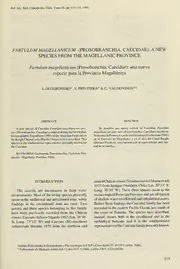
Fartulum magellanicum (Prosobranchia, Caecidae): a new species from the Magellanic Province PDF
Preview Fartulum magellanicum (Prosobranchia, Caecidae): a new species from the Magellanic Province
) Bol.Soc.Biol.Concepción,Chile.Tomo66,pp.113-118,1995. FARTULUMMAGELLANICUM (PROSOBRANCHIA, CAECIDAE):ANEW SPECIES FROMTHEMAGELLANIC PROVINCE Fartulummagellanicum (Prosobranchia, Caecidae): unanueva especieparalaProvinciaMagallánica I.DIGERÓNIMO*,S.PRIVITERA*&C.VALDOVINOS*=' ABSTRACT RESUMEN AnewspeciesofCaecidaeFartulummagellanicumspec. Se describe una nueva especie de Caecidae, Fartulum nov.(Prosobranchia:Caecidae),sampledduringtheFirstItalian magellanicumspec.nov.(Prosobranchia:Caecidae),recolecta- OthceeaBneoaggrlaepChhiacnnEexpleádrietaio(Pna(ci1f9i9c1O)cienatnh)eiMsahgeerleldaenscSrtriabietd.anTdhiisn ednadeulraEnstterelachPoridmeerMaaEgxapleldainceisónyOecneaenlógárreaafidcealICtaalniaalnaB(e1a9g9l1e speciesisthesouthernmostrepresentativepresentlyknownfor (OcéanoPacífico),correspondiendoalrepresentantemásaus- theCaecidae. traldelafamilia. KEYWORDS;Gastropoda.Prosobranchia.Fartulum.New species.MagellanicProvince.Chile. INTRODUCTION centralChileancoasts;FartulummooreiMarineovich 1973fromIquique(NorthernChile;Lat.20°13' S; The caecids are uncommon in deep water Long.70°10' W).Thesethreespeciesoccurinthe environments.Mostofthehvingspeciespresently malacologicalPeruvianProvinceandarealltypical occurinthemidlittoralandinfralittoralzone,while ofshallowwater(midlittoralandinfralittoralzone). findings in the circalittoral zone are rarer. Two BeforethesefindingstheCaecidaefamilyhasbeen generaandthree species belonging to this family recordedintheeastemPacificOcean,justsouthof have been previously recorded from the Chilean the coast of Panamá. The species here described, coasts:CaecumchilenseStuardo1962(Lat.36°46' instead, occurs both in the circalittoral and in the S; Long. 73°12' W) and Caecum (Micranellum) epibathyal bottoms and it is the southernmost subaustrale Stuardo 1970 from the northem and representativeoftheCaecidaefamilypresentlyknown. *IstitutoPolicattedradiOceanologíaePaleoecologia(I.P.O.P.)CorsoItalia55,95129Catania, Italia. **LaboratoriodeBiologíaAmbiental,CentroEULA-Chile,casilla156C,Concepción. 113 Bol.Soc.Biol.Concepción,Chile.Tomo66, 1995 RESULTS 7 Paratypes of F. moorei n. 1592 from the Natural History MuseumofLos Angeles County FamilyCaecidae havebeenalsoexamined. FartulumCarpenler, 1857 Fartulummagellanicumspec.nov. Description:Teleoconchcylindrical,moderately (PíateI,Figs. 1 -5) curved,vitreousorlightlyopaqueinlessfreshshells. Undertheopticalmicroscope,surfaceseemsentirely Material: The description is based on the smooth, with less distinct annular growth striae. specimenscollectedduringtheFirstOceanographic Using the SEM these striae are rather thick, ItalianExpedition(1991)alongthe570kmofthe irregularlydistancedandlittleengraved.Aperture MagellanStraitandintheáreaoftheBeagleChannel circular with a thin lip folded outwards. Septum withtheRA'"Cariboo"and"OGSExplora". welldeveloped, obliqueangledtothebackofthe shell.Máximumdiameter,ataperture,isconstantto a) RA^ "Cariboo" (Van Veen Grab, 0.1 m-): middleoftheteleoconchwhiletheposteriordiameter Stn, 1 (52°45' S;74°59'W),20specimensfroma isalwayssmaller.Operculumandsoftpartsnotknown. sampleoforganogeniasandinfrontofthePacific entranceoftheStraitofMagellan (depth 100m- Variability:Thedimensionalcharacteristicsof CaboDeseado). alltheunbrokenspecimenscomingfrom4ofthe5 sampledstationsofoccurrence(Tab.I)wererecorded. b) RA' "OGS Explora"(VanVeenGrab,0.1 Thespecimenshavealengthrangeincludedbetween m-): Stn. 38(52°46' S;74°59' W),40specimens 0.85and2mm.Diameterataperturebetween0.15and fromadepthofl05mandStn.39(52°17'S;74°25' 0.35mm.Thesevalúesareconstantalsoatthemiddle W),1specimencomingfromadepthof125mfrom oftheteleoconch,whilethediameterattheposterior samplesoforganogenicsandoffthePacificentrance endvariesbetween0.10and0.30mm. oftheMagellan Strait; Stn. 11 (55°07' S; 65°55' W), 10 specimens from samples of organogenic F.magellanicumspec.nov.hasanaveragelength sandtakenfromadepthof 190mofftheeastem of1.33mm,meandiameterattheapertureis0.25mm entranceofBeagleChannel;Stn. 11bis(55°13'S; and at the middle ofthe teleoconch is 0.24 mm, 66°00' W), 15 specimens from samples of whiletheseptalenddiameteris0.19mm.Themean organogenicsandtakenfromadepthof245moff oftheratiobetweentheaperturediameterandthe theeastementranceofBeagleChannel(Fig. 1). posteriorenddiameteris 1.16. Figure1.PacificsectoroftheStraitofMagellanandtheCanalBeagleárea.Loeationofsamplingstations. 114 Bol.Soc.Biol.Concepción,Chile.Tomo66,1995 TABLEI.Dimensionalfeatures(mm)ofFartulummagellamicumspec.nov. SPECIES Bol,Soc.Biol.Concepción,Chile.Tomo66,1995 Holotype: The holotype has a total length of 37°20'S(Stuardo1962;1970;Marincovich1973). 1.45 mm, aperture diameter of 0.25 mm, in the BetweenSanVicenteBayandtheGulfofArauco middleoftheteleoconchof0.25mmandadiameter (personal data, unpublished), in substrata of attheposteriorendof0.20mm.Allthespecimens organogenicsandincludedbetweenthelowintertidal are deposited at the Museum of the Istituto and72mofdepth.C.(M.)subaustraleStuardois Policattedra di Oceanologia e Paleoecologia of presently known forthe type locality (in frontof Catania University. Holotype n. MI. 8.8.95; LosVilos;31°54'S;71°32'W),atadepthof10m Paratypesstaz.1n.Ml/A;staz.38n.Ml/B;staz.11 onabottomoforganogenicsand. AlsoF. moorei n.Ml/C;staz. 11 bisn.Ml/D. Marincovich,thespeciesthatforitsmorphological characteristic is closer to F. magellanicum spec. Typelocality:TypelocalityisStn. 1locatedon nov.,isknownonlyforthetypelocality(Iquique, thecontinentalshelfoffthePacificentranceofthe 20°13'Sand70°10'W)inthelowintertidalzone. MagellanStrait,offCaboDeseado(52°45' S;74° 59' W)atadepthof100m(Fig.l). Stuardo (1970) reports of the existence of anotherspeciesofCaecumfromsouthernChile, Affinity:BetweenthethreespeciesofChilean whosedescriptionwasexpectedwiththeresults Caecidaepresentlyknown,theclosesttothespecies ofthe study ofProsobranch molluscs collected here described is Fartuliim inoorei Marincovich. bytheLundExpeditioninChileduring 1948-49. Boththespeciesarecharacterizedbyanapparently Theseresults,however,tilltodayareunpublished smoothshell.TheseptumofF.mooreiisdepressed and it was not possible to trace the preserved anditsmueroisanglednearly90°toright,whileF. material. magellanicumspec.fwv.hasaslenderdome-shaped AllthespecimensofF.magellanicumspec.nov. septum. The aperture is completely different, F. were found in a sediment of organogenic white magellanicumspec.nov.hasafoldedouterlipwhich sand. This datum agrees with the endopsammic isinsteadlackinginF.moorei.F.magellanicumspec. behaviourofthecaecidthatduetotheirdiminutive nov. ismoreslenderthanF.moorei whichislarger. sizes, the slender form of the shell, the ciliar movementthattheyhave,arestrictlysand-inhabiting species. Observations made in the laboratory DISCUSSION (Panetta, 1980) on living specimens of two Mediterranean species showed that the Caecum Fartulummagellanicumspec.nov.isprobably move with a surprising agility in the sediment, the southernmost species ofthe Caecidae family feeding on unicellular organisms (diatomee) that presently known for the Chilean coasts, its theygrazefromgrainsofsand.AmaudandPoizat distributionaláreabeingincludedbetween52°and (1979)affirminastudymadeonthedistributionof 55°SandincludedintheMalacologicalMagellanic theCaecidaeintheGulfofMarseille(France)that Province(Stuardo, 1964). this genera seems to prefer sandy bottoms ThethreespeciesofCaecidaepresentlyknown particularly exposed to strong (medium-high) for the Chilean coasts are distributed around the hydrodynamism.Theseecologicalconditionsseem centralandnorthernpartofChileandalloccurin tobethesameasthosepresentonthebottomsofthe the Peruvian Province. Morphometrical and Pacific shelf and the western threshold of the geographicaldataaresuppliedinTab.II.C.chilense Magellan Strait and the eastem entrance of the Stuardo is the more common species and has its BeagleChannel,wherethespecimensherestudied distributionaláreaincludedbetween 12°30' Sand werefound.Thisfactseemstobestrengthenedby TABLEII.FeaturesoftheCaecidaespeciesfromthechileancoast(dimensióninmm). TYPELOCALin DEPTH SEDIMENT BIOGEOGRAPHICALLATITUDINAL PROVINCE RANGE length diara.> Mid-Teleoc. d¡am.< CaecumchilenseSTUARDO 1.98 0.49 Corara(M.)sutosíra/eSTUARDO2.26 FaniilmmooreiMARINCOVICH 1.55 Fartulummagellamcumspec.nov. 1.45 Bol.Soc.Biol.Concepción,Chile.Tomo66,1995 PLATEI.Fig.1.HolotypeofFartuluminagellanicumspec.nov.,offCaboDeseado(PacificOcean)Stn.1;100metres.Fig.2.Paratypeof F. magellanicumspec.nov.,Stn.1;100metres.Fig.3.Youngshellwhichstillretainsitsinitialspiralcoil.Fig.4.Holotype:detallofthe shapeoftheseptum.Fig.5.Holotype:detailoftheaperture,outerlipandsculpture.Fig.6,ParatypeofF.mooreiMarincovichfromIquique (Chile).Fig.7.Caeciim(Micranelliim)subaustraleStuardofromSanVicenteBay(Chile).Fig.8.CaecumchilenseStuardo,reproduction oftheholotypefromStuardo(1970). 117 Bol.Soc.Biol.Concepción,Chile.Tomo66,1995 ACKNOWLEDGEMENTS the condition of general freshness of shells that indicate a minimum incidence of transpon. The three species of Caecid known for the central- WearegratefultoDr.LouieMarincovichand northemChileancoastsprefercoarseorganogenic Dr. James McLean curator ofthe Malacological sandy beach environments with strong médium Section of the Natural History Museum of Los hydrodynamism and a constant current on the AngelesCountyforkindhelpandforhavingsentus bottom. someparatypesoíF.moorei.Wewanttothankalso Thebathymetricdistributionoff.magellanicum Prof.AntonioBrambati,Prof.NevioPuglieseand spec.nov. isbetweentheouterpartofthecontinen- Dr. Giorgio Fontolan ofthe Institute ofGeology talshelfandtheupperpartofthecontinentalslope andPaleontologyoftheUniversityofTrieste,for between 100 and 245 mofdepth. The sediments havingsentthesedimentsoftheexpeditionofthe where the species has been found are typically RA' "OGS Explora"; Mr. Orazio Torrisi of the sandyorganogenicbottoms(médiumcoarsesand), InternationalInstituteofVolcanologyofCataniafor in relation with the medium-strong flooding and theSEMphotos. ebbing currents that are present in the eastem PNRA Biological Oceanographic sector, entrance of Beagle Channel and in the western ProgrammeonBenthicCommunities,UnitofCatania, entranceofMagellanStrait. ResponsibleProf.S.DiGerónimo,Paper26. REFERENCES Arnaud,P.M.&C.Poizat.1979.Donnéesécologiquessurdes Stuardo,J.1962. Caecumc/n/e/we,nuevomoluscoparaChile. Caecidae (Gasteropodes Prosobranches) du Golfe de CayanaZool.,5:1-8,2figs. Marseille.Malacologia,Proc.SixthEurop.Malac.Congr., Stuardo, J.1964.Distribucióndelosmoluscosmarinoslitora- 18:319-326. lesenLatinoamérica.Bol.Inst.Biol.Mar.,MardelPlata, Marincovich,L. 1973.IntertidalMoUusksofIquique,Chile. 7:79-91. Bull.Nat.Hist.Mus.LosAngelesCounty,16:1-49,102 Stuardo,J.1970.Sobrelosrepresentanteschilenosdelafamilia figs. Caecidae(MoUusca:Gastropoda).Bol.Soc.Biol.Concep- Panetta,P.1980.LafamigliaCaecidaenelMediterráneo.Boíl. ción,47:183-190,2figs.,1tab. Malacologico,Milano,7-8:277-300,1fig.,4pls. 118
